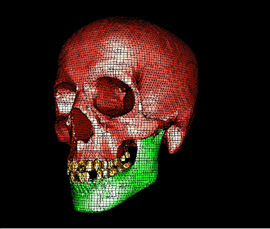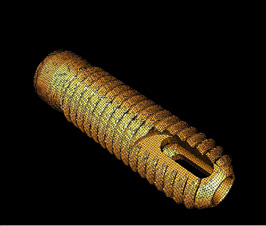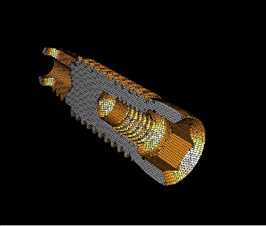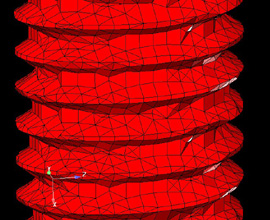Latest News
December 1, 2004
By Karen Whichard
|
This detailed surface meshing of a skull is used for study of craniofacial surgery, growth, and development. A 3D wireframe was created in SolidWorks, exported in .STL format, then meshed with CEI’s Harpoon. The mesh is easily imported into an FEA program such as MSC.MARC for analysis to determine the correct placement and size dental implant. |
While military applications and crash simulations have long been hot areas for computational solid mechanics, advanced computer software is bringing biomechanics—with its highly complex structures and morphologies—deeper into the fold. Research in cell behavior, the nervous system, and even dental implants and fillings are all benefiting from timesaving advances in meshing technology typically used in the automotive and aerospace industries.
Dr. Ronald Sakaguchi, associate dean for technology and innovation at Oregon Health and Science University in Portland, studies the mechanics of biomedical devices. His team’s research into dental implants and restorations under varying loads helps improve designs for manufacturers.
Meshing the Threads
Analysis of meshes is a critical component of biomedical device research. In the case of FEA (finite element analysis) of threaded dental implants, meshing the helical threads, especially the root of the threads, presents challenges because it typically results in tetrahedral elements with poor aspect ratios. Until recently, meshing was done by manually creating individual elements, which required several weeks or months of effort.
| |
|
|
| |
A full view and cross-section of a dental implant assembly including the section that is embedded in bone, the abutment that connects the implant to the tooth replacement (crown), and the internal screw that retains the abutment to the implant. The closeup view (bottom) shows the detailed meshing of helical threads accomplished by Harpoon, which uses hexahedral elements to speed the process and cut down on cleanup. |
“Constructing the model geometry and generating the finite element mesh was very time-consuming,” says Dr. Sakaguchi. “A disproportionate amount of time was spent creating the geometry rather than doing the actual analysis and research.”
To speed up the meshing process, Dr. Sakaguchi uses Harpoon, a hex-dominant mesher from Computational Engineering International (CEI) of Apex, N.C. He says that Harpoon creates complex meshes that do not require additional software patches, and only minimal hand cleanup is needed. Meshes created by Harpoon allow flexibility in density, which enables Dr. Sakaguchi to solve FEA problems quickly and correctly.
“For the first time,” says Dr. Sakaguchi, “we were able to solve an FEA model of the dental implant using the exact dimensions of the finished product provided by the CAD file used in manufacturing. I can now take a SolidWorks CAD file of a dental implant, mesh it in Harpoon, and then solve for stresses and displacements using an FEA solver, usually MSC.MARC, in minutes.”
Boiling down multiple time-consuming processes into three key steps, Dr. Sakaguchi and his team are able to more fully explore “what-if” scenarios. By using this virtual prototyping procedure, the number of physical prototypes and amount of bench testing can be greatly minimized. This typically reduces the number of designs used in clinical trials, allowing medical and dental device manufactures to bring improved products to market more quickly.
It’s Not Just About Teeth
Dr. Sakaguchi’s research team leverages the tools developed for biomedical analysis of dental implants and restorations in other areas as well. For example, they use the same processes to study the mechanics of vascular stents used in heart surgery to keep blood flowing through vessels after balloon angioplasty procedures.
By cutting the time needed to create design geometries, Dr. Sakaguchi and his colleagues are able to create structural models ready for testing sooner. The payoff is less time needed to perform required FDA tests, again bringing improved stents to the marketplace faster.
“By using advanced meshing to bridge between CAD and finite element analysis, I’ve been able to eliminate 90 percent of the time previously spent to build models for research,” says Dr. Sakaguchi. “Computational biomechanics benefits tremendously from the speed and accuracy of this meshing.”
Karen Whichard specializes in computer graphics and other technology areas. You can send Karen your comments about this article through e-mail c/o [email protected].
Speed Plus Accuracy
Harpoon meshing software is based on proprietary meshing algorithms that provide fast processing and enable automated clean up of CAD files. Developed over two years, the program’s goal is to erase the traditional bottlenecks associated with meshing for complex CFD (computational fluid dynamics), FEA, and other simulations.
In solving for biomedical devices such as dental implants, designers must confront complex geometries. The quality of a mesh starts with the CAD file, which often has such problems as holes and non-watertight surfaces with gaps, overlaps, and intersecting facets. Harpoon automatically fixes these hindrances in the course of creating boundary-fitted cells, and it does this at speeds of two million cells per minute or more on standard laptops, according to CEI.
Speed, of course, is worthless if the quality of the mesh is poor. If the user needs to go through several time-eating iterations to get a quality mesh, the speed at which the mesh is generated is irrelevant. Ideally, a mesh would consist entirely of perfect cubes; that is what Harpoon strives to do. It deviates from ideal cells only when needed, typically near model boundaries and surfaces. And the non-cubic cells are created with an optimization method that is said to ensure the highest possible accuracy.— KW
Company Information
Harpoon
Computational Engineering
International — CEI
Apex, NC
ceintl.com
MSC.Marc
MSC.Software Corp.
Santa Ana, CA
mscsoftware.com
SolidWorks
SolidWorks Corp.
Concord, MA
solidworks.com
Subscribe to our FREE magazine, FREE email newsletters or both!
Latest News
About the Author
DE’s editors contribute news and new product announcements to Digital Engineering.
Press releases may be sent to them via [email protected].










